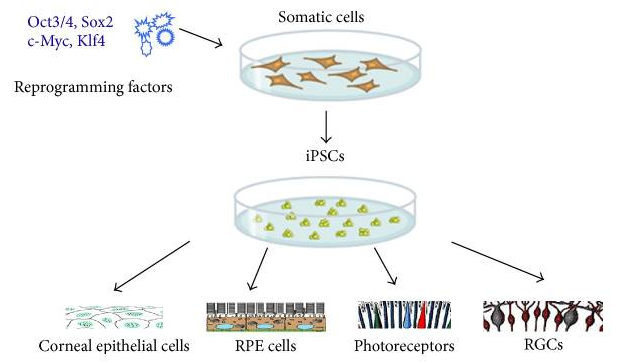Human induced pluripotent stem cells (iPSCs) derived from human somatic cells can differentiate into a variety of ocular cells such as corneal epithelial cells and retinal pigment epithelium cells. These cells provide effective tools for ophthalmologic disease modeling and personal drug development using stem cells as well as developing cell-based therapy.
The ophthalmologic disease is a general term for the diseases occurring in all components of the eye, characterized by visual impairment. It is estimated that about 4.2 million Americans aged 40 or older are either blind or are with low vision according to the National Eye Institute (NEI) and the CDC. Common eye diseases include:
AMD is a major cause of vision loss in Americans over 60 years of age, affecting over 600,000 people. This disease can blur the central vision. There are two main types of AMD: dry and wet. Dry AMD is common, accounting for 90% of AMD cases. Wet AMD is an advanced form, causing about 90% of serious vision loss.
A cataract is a cloudy area formed in the lens of the eye. It is also a major cause of vision loss. Over half of all Americans age 80 or older suffer from cataracts or have undergone cataract surgery.
Diabetic retinopathy is a complication of diabetes that affects the eyes. It is caused by damage to blood vessels in photosensitive tissue at the back of the eye (retina). Initially, any symptoms maybe not be observed in patients with diabetic retinopathy, or only mild vision problems. But, it eventually leads to blindness.
Glaucoma is a group of eye diseases that damage the optic nerve. The damage is usually caused by abnormally high pressure in the eyes. Glaucoma is one of the leading causes of blindness in people over 60 years of age.
iPSCs are a type of pluripotent stem cells that can be derived from human somatic cells by introducing certain transcription factors. These stem cells can differentiate into various ocular cells including corneal epithelial-like cells, retinal pigment epithelium cells. These cells offer an opportunity to access the genetic information of patients with ophthalmologic diseases and allow identification of the disease-initiating events. Besides, these cells also provide effective models for novel patient-specific treatments. It may be an excellent way to restore visual function in some untreatable ocular diseases such as age-related macular degeneration, retinitis pigmentosa, and glaucoma by replacing damaged or diseased ocular cells with iPSCs-derived ocular cells such as corneal epithelial cells, retinal pigment epithelium, photoreceptors, and retinal ganglion cells. Transplantation of ocular cells derived from iPSCs in animal models has shown great promise for reversing blindness. Although iPSCs exhibit great potential for the treatment of ocular diseases, more research is required to validate the safety and effectiveness of transplantation of iPSCs-derived ocular cells.
 Fig.1 Schematic illustration of iPSC induction and reprogramming into ocular cells.1
Fig.1 Schematic illustration of iPSC induction and reprogramming into ocular cells.1
Integrating with advanced iPSC technology and rich expertise in iPSC-based modeling as well as drug discovery, Creative Biolabs is committed to offering the best iPSC-related basic research services, involving iPSC reprogramming, differentiation, and characterization. Besides, we also offer optimal solutions for iPSC-based ophthalmologic disease modeling and novel drug discovery. If you are interested in our services, please contact us to discuss your project and achieve more details.
Reference
For Research Use Only. Not For Clinical Use.